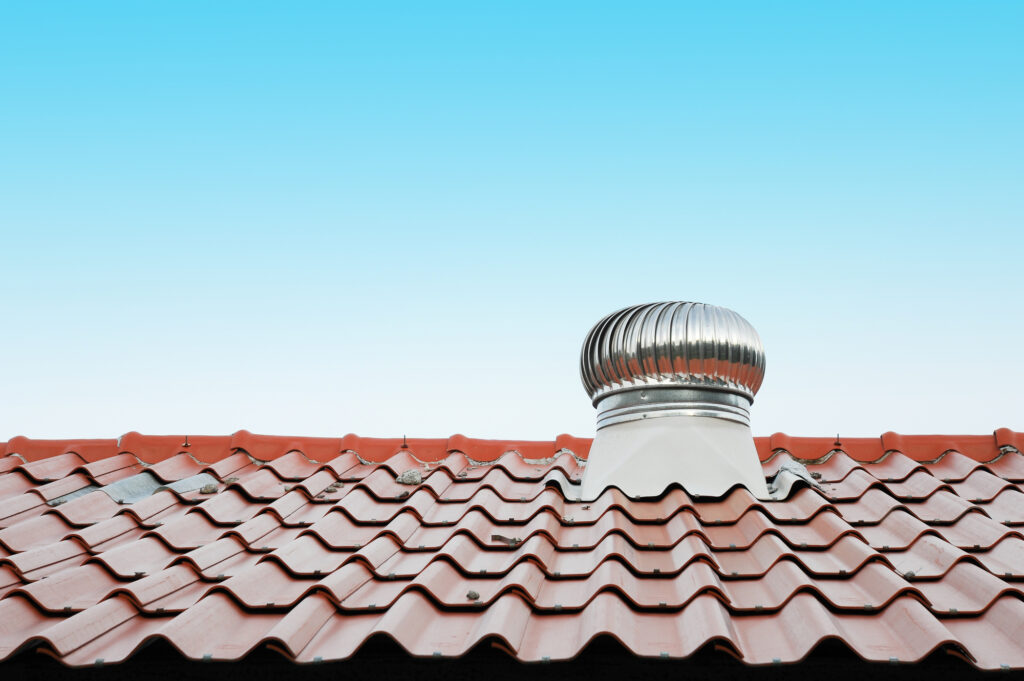One advantage of wind energy, as highlighted by the U.S. Department of Energy, is that it is a clean and unlimited energy source. Consequently, even the localized use of wind power, such as the residential installation of turbine vents, is an eco-conscious choice for consumers. The following provides a high level overview outlining the function of roof turbines and some key installation considerations. Want to support the health of your home as well as the planet? Looking for a ventilation option that offers visual appeal while performing an essential home function? Take a look at roof turbines!
Roof Turbine Design and Benefits
Roof turbines are also known as turbine vents or sometimes by their most common type – the whirlybird. While the specific components may vary by model or maker, two key parts are the dome or head of the turbine (the topmost part) which catches the wind and the vanes or blades which use the converted energy from that wind to draw air out of the attic. Some designs include features like adjustable thermostats to further regulate fan speed based on the attic temperature.
Available in multiple styles and designs, roof turbines are one of the easier vents to install and are relatively low maintenance. Unlike other types of roof vents, such as the ridge vent, which can be almost indistinguishable once integrated into the roof, turbine vents are a more distinctive ventilation feature. Consequently, property owners may either choose a color that aligns with the roofing materials or a more distinct option that complements or enhances the building’s aesthetic nuances. For example, a black turbine may be chosen to provide color contrast or to blend with the surrounding roof color. White roof turbines might work better for lighter roofing installations or to further reduce any additional heat absorption. For an especially unique addition, some people opt for weathered bronze or copper selections.
Additionally, turbine vents contribute to a home’s energy efficiency and roof lifespan. Leveraging the power of wind, roof turbines support temperature and moisture management as well as air quality and circulation inside the home. These essential functions enhance the interior environment of the home and also serve the important purpose of protecting the roofing installation and insulation. Here are three key benefits for these two components of your home:
- Especially in New England’s colder months, roof ventilation helps reduce the risk of ice dams, which can cause leaks and may result in roofing material decay.
- During the heat of July and August, roof turbines reduce the likelihood that temperatures will climb to the point of causing stress on roofing structures as well as higher air conditioning bills.
- With too much moisture, the roofing structure may age faster or be compromised by warping or other decay. Similarly, wet or damp insulation won’t be as effective and may become a prime area for mold or mildew to grow. Turbine vents move excessive moisture out from underneath the roof to help avoid these issues.
Turbine Vent Installation: To Cover or Not to Cover?
To design the most effective and efficient ventilation system for your home, your local roofing expert will consider factors like wind patterns and other climate particulars, roofing material, roof slope, and shape, and the square footage of any attic space. An additional consideration, specific to turbine vents, is whether or not to use a roof turbine cover. While there is substantial reasoning for either choice, your roofing specialist will be best able to help you determine if, how, and when a turbine vent cover may be right for you.
Benefits of roof turbine covers:
- Greater protection of the vent’s internal components may increase the lifespan of the vent, especially in seasons where its use may not be as essential.
- Covers can help prevent animal and insect intruders from creating nests in the turbine vent or otherwise using it as an entry point into the home.
- Similarly, this barrier can prevent debris like leaves or twigs from building up in the vent and either blocking it or partially compromising its operation.
- Covering turbine vents can help reduce the potential for rainwater or melting snow to leak into the attic and cause the kind of issues that effective ventilation should be helping to avoid.
Cautions about covering turbine vents:
- Roof turbines are generally a low-maintenance ventilation choice. Although most covers aren’t difficult to add or remove, there will be one more item to negotiate before checking on any potential operational issues. They may also require some additional time on the roof.
- Covers may impact overall ventilation performance. Consequently, the turbine vent may not have the desired level of energy efficiency.
- Adding a cover can make a turbine vent even more noticeable on a home. If a turbine vent finish has been chosen to enhance the look of the home, covering it will reduce the impact or appeal of that selection.
Is it time for a new roof? Are you hoping to improve the energy efficiency of your home? If so and for those in the greater Boston area, tell us about your roof, so that one of the experts at Ranch Roofing can start to collaborate with you on all of your roofing needs. From the type of roofing to the ideal combination of roof turbines and other types of attic ventilation, our team looks forward to collaborating with you on your upcoming project. Contact us today!
